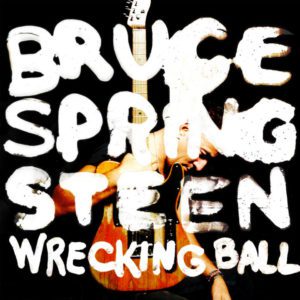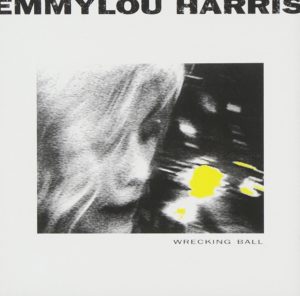
In February 2011 a discussion forum thread was posted on the website of DHS Diecast, a collectables company specializing in miniatures and models from the world of construction, entitled “The long lost art of the wrecking ball.” “Balling is an art form, you can’t put any stick monkey in the machine,” one group member writes, lamenting the fact that fewer and fewer wrecking balls are being used as construction companies opt for excavators and other more nuanced demolition techniques. It is strange to think of such reverence being reserved for a piece of construction equipment, but it speaks to the totemic importance of the wrecking ball in American post-war culture.
Where wrecking balls continue to operate is in the hazy, imagined world of heartland rock and Americana, and in here, the art of the tool continues to be fully articulated. The wide, swinging arcs of 10,000 pounds of steel are rendered into crashing, anthemic choruses—songs of hope, of last hurrahs, of self-reliance and a general feel of getting shit done. However, the wanton carnage a wrecking ball creates—bricks and mortar and dust and masonry ripping apart, falling to the floor—is never far away. There is hope, and hopelessness, whenever wrecking balls are sung.
It took seventeen albums for Bruce Springsteen to write Wrecking Ball. Springsteen is as close to a real-life superhero as America has, the E Street Band his able deputies. But in 2012, when Wrecking Ball was released, a shroud of mortality had been thrown over the group—the previous year, Clarence Clemons suffered a stroke and passed away, leaving a seismic gap in the band’s look and sound. Before that, when the song cycle was being conceived, Wrecking Ball saw Springsteen reverting to themes and imagery that he had erected in his early years. In his autobiography Born to Run, he describes the album as “a shot of anger at the injustice that continues on and has widened with deregulation, dysfunctional regulatory agencies and capitalism gone wild at the expense of hardworking Americans.”
“I was raised out of steel here in the swamps of Jersey, some misty years ago,” he begins. In a sense, for Bruce Springsteen to start a new song saying that he was raised in working class New Jersey is ridiculous, given just how self-evident a fact it is in the singer’s work. However, the reminder is telling. It is a reiteration of his credentials, of his authenticity, at a time when so much of his audience felt let down. The song is also deliberately empowering, its imagery full of might and strength delivered to an audience who had begun to feel disenfranchised—mosquitoes big as airplanes, arenas filled, giants, champions. Bruce’s evocation of the wrecking ball is the apex of this, a testament to the strength of the working class set against a newly poignant toast: “Raise up all your glasses / let me hear your voices call / ’cause tonight all the dead are here / so bring on your wrecking ball.” Earlier in the song, the first verse sounds with the righteous anger that Springsteen highlighted in his autobiography: “So if you got the guts mister / yeah if you’ve got the balls / If you think it’s your time, then step to the line / and bring on your wrecking ball.” With the song’s close, the wrecking ball becomes a last resort, a resignation, a purge even. “Hard times come / and hard times go / just to come again / bring on your wrecking ball,” Springsteen sings.
The song ends, in true, golden-era Bruce style, with a garrumping “one, two, one-two-three-four!” and a horn solo. Every single time I listen to it, I expect the reedy snarl of Clarence’s sax rather than a trumpet. “Tonight all the dead are here…” This line, and this coda, bookend the song like a rhyming couplet. The strength and resilience that Springsteen evokes and embodies is condensed in the lyric, while at the song’s end, you have this sentiment made real. Clarence is present by his absence, as he will always be present in that band. Those solos, those runs, will always be his. The songs survive, the band survives, and, in turn, the audience survives, all in the face of the economic pressures that Springsteen rails against.
“There is a romance to the wrecking ball. A kind of poetry to it. During the 1950s and 60s, it was a time when demolition was associated with progress and optimism. It was an agent of opportunity for America, and for the world. There was a sense that we were making way for the future. I think the wrecking ball is proudly associated with that idea.” – Jeff Byles, author of Rubble: Unearthing the History of Demolition
The kind of semantic inflation possessed by the word “romance” gives people license to use it to describe any number of things they cannot account for in some other way. Byles takes up the baton here, and with more color, in this New York Times piece from 2006, tacitly associating the ubiquity of the wrecking ball in American culture, pre- and post-war, with a kind of overhead chaotic pantomime. The unmaking and remaking of a cityscape, an urban itchy feet. The industry, the wreckers, played up to the pageantry. It becomes a symbol wherein all hope to claim a victory. So, when restauranteur Toots Shor’s much-loved New York saloon was to be demolished to make way for a hotel, he honored the sports bar theme by having the wrecking ball painted like a baseball, and posing with the rubble—looking, it must be said, pretty cheery, for someone who’s bar just got destroyed.
Gillian Welch’s “Wrecking Ball,” from her 2003 album Soul Journey, feels like it’s speaking to that same romance—a tetchy, hysteric, excitable energy that inevitably gets sucked under the wheels of its own momentum. If Bruce’s “Wrecking Ball” was solid and strong, Gillian’s “Wrecking Ball” is swinging out of control. There’s notes of autobiography in the lyrics, but essentially it’s a story of moving out west and burning out on drugs; and, as such, the song fits into a broader American literary narrative, something Welch is particularly adept at doing.
The “like a wrecking ball” refrain that sounds throughout the song refers to a journey, a realization; drugs, alcohol, a relationship; before finally coming to refer to the object’s literal purpose—destruction. But prior to that, the song’s story is intoxicating and romantic, the wrecking ball a shape-shifting, quixotic emblem of the narrator’s bittersweet voyage, rattled out in the repeated refrain with far more rock and far more roll than maybe one would have expected from an alt-country revivalist.
“I met a lovesick daughter of the San Joaquin / she showed me colors I’d never seen / drank the bottom out of my canteen / then left me in the fall / like a wrecking ball,” Welch sings.
Talking about the early days of the wrecking ball in New York City, Byles again leans into the spectacle of it: “demolition was an evocative, even enthralling part of the urban scene. Sidewalk superintendents were agog at the daredevilry on display.” Welch does the same, throwing herself into the hedonism of ’80s California, before coming down in the final verse: “Was ridin’ high until the ’89 quake / hit the Santa Cruz garden mall / like a wrecking ball.” She captures the moment inside of the act of demolition and destruction that a wrecking ball performs, when a person realizes that surrounding yourself with destruction just ends up destroying you.
Prior to wrecking balls, buildings were demolished in a much less efficient way. That is to say, they were torn apart piece by piece by laborers known as “barmen.” Huge structures, picked apart by crowbars, pickaxes, hands, and then, more often than not, salvaged, recycled, repurposed, put to work again. Byles writes: “fixtures and appliances were sold; wood studs and flooring pried up, studiously denailed, and tied in bundles for reuse; and bricks cleaned by fiendish characters who could knock the mortar off 5,000 bricks a day. Laborious, yes. Wasteful, no. It was an elegant way to wreck.”
The wrecking ball put these people out of work with its brute force efficiency, but the sad irony of industrialization is that it’s a never-ending cycle of obsolescence, as evident in the forum thread on DHS Diecast. The ball’s place in industrial obsolescence, however, also contributes to the object’s myth—it is notable by its absence precisely because its absence leaves such a big hole. More than that, its disappearance helps to create a crystallization of its metaphor: one big thing hits another big thing, and the other big thing crumbles. When used in a song, the singer and the listener are invariably the thing that crumbles.
With perhaps the sole exception of country guitar-slinger Eric “Take Me To Church!” Church, who, in maybe the most embarrassingly braggadocio moment in recent mainstream country music history, uses the image to describe his dick (“I’ma find out what that house is made of / been too many nights since its felt us make love / I wanna rock some Sheetrock, knock some pictures off the wall / love you baby / like a wrecking ball”), the position of the wrecking ball in song is to create this binary of strength and vulnerability. A brutish device to mirror brutish demolition. Gifted songwriters like Springsteen and Welch can bend this metaphor to the will of their respective, and disparate, narratives. In the case of an unabashed pop star like Miley Cyrus, albeit one with achy-breaky roots in country music, the singer often gives themselves over to the weight of the metaphor.
In the video for Cyrus’s “Wrecking Ball,” before the chorus kicks in and we get the now-infamous shots of her swinging around naked on titular object, the sense of vulnerability is already there. Staring glassy-eyed, directly through the camera, a self-conscious nod to Sinead O’Connor’s video for “Nothing Compares 2 U,” she spits out the opening lines teary and broken. These moments of the video are actually quite affecting, and tally with the mood of the song, although they aren’t the reason it went viral so quickly. Given her recent disavowal of the video, coupled with the fact it was directed by alleged sexual predator Terry Richardson, and finally Cyrus’s admission that she was high during filming, the whole thing feels even more uncomfortable and exploitative to watch now than it did upon its initial release.
With the wrecking ball image transformed into this piece of hyper-sexual fantasy, rendered literally through the male gaze, and paired with the deliberately phallic sledgehammer, Cyrus’s song about a woman’s vulnerability and recklessness, sung with extreme candor about a relationship that sparks with volatility, is deliberately misunderstood. When she sings “I came in like a wrecking ball,” it’s not in an obnoxious, Eric “Take Me To Church!” Church way; Cyrus’s lyrics are not elevating her sexuality to this bruising, untethered thing. Nor is it comparable to how St. Vincent sings “bodies like wrecking balls fuck / fuck with dynamite” in “The Sequel.” Rather, Cyrus is not specifically referring to her sexuality at all. Lyrically the song deals more in PG-13 romantic generalities than explicitness: “We kissed / I fell under your spell / a love no one could deny.” For a song that was intended to mark a stark departure from her teeny-bopper days catfishing country fans on Hannah Montana, its content is still quite Disneyfied.
That Richardson decided to eroticize the song’s central image, as well as its author, says more about his intentions than those of Cyrus’s rendition of the wrecking ball as a symbol. In his control, the wrecking ball transforms into a violent, Futurist emblem. In her essay “Rhetorical Strategies and Gender in Marinetti’s Futurist Manifesto,” Cinzia Blum, professor of Italian at the University of Iowa, calls machines “the great fetish of Futurist mythology—an ‘other’ which offers a reassuring mirror image of the subject’s desire for power.” Blum also notes that futurism employs “a strategy in which femininity works as a mark of impotence, disease, and fragmentation.” Richardson firmly aligns himself with this view of machine-as-object, destroying the meaning of the song and rebuilding it into something more palatable to a male audience, both figuratively and literally. We are allowed to see Cyrus emotionally fraught at the start of the video because in Richardson’s mind, it colors the explicitness as empowering, rather than exploitative, but even if that were the case, Richardson’s choices still pull the metaphor into an uncomfortable place—if the strength of the wrecking ball is divorced from the thing being wrecked, then it is inanimate. Objectified. Even in the visuals, Richardson’s reading of the song is belied by just how easily everything crumbles, how tacky everything looks. Cyrus’s lyrics, on the other hand, understands how to use the metaphor by acknowledging both sides of it, and also shifting her position within it: “all I wanted was to break your walls / all you ever did was wreck me.”
Potential energy is an interesting concept, in that it imbues an inanimate object with life only in relation to other things. A wrecking ball pulled to the top of its arc has as much potential energy as the work enacted against gravity to lift it that high—at that point, it is still, but it has been given meaning. For all of the wrecking ball’s ubiquity in music, it’s hard to pin down the first writer to use it, although Neil Young may have as good a claim as any. “Meet me at the wrecking ball / wrecking ball, wear something pretty and white / and we’ll go dancing tonight,” he sang in 1989. The song doesn’t have as much impetus as those that would come after it—it kind of hangs in the air, languorous and washed out—and maybe that’s purely because the wrecking ball isn’t actually in the song at all, it’s just used to name a bar. In 1989, wrecking balls hadn’t yet completely given way to more efficient methods of demolition, and so as a concept, they bring less to the table. The nucleus of the metaphor is there, but it’s not yet quite taken hold. Like many nascent cultural symbols, the song’s wrecking ball is more of a suggestion, a place to start, than a tale in and of itself.
Potential energy yet to be converted into kinetic energy. If Neil Young first did the work against gravity, then it was Emmylou Harris who sat behind the pistons and let the ball swing with her 1995 album Wrecking Ball, the title track being a cover of Young’s song. American Songwriter’s Jaymie Baxley argues that for Harris, the mid-’90s were a difficult time:
A new breed of cowgirl had arrived. Bubbly, easygoing, free-spirited: these firebrands bore little resemblance to their introspective and comparatively dignified predecessors. Furthermore, America’s regrettable obsession with line-dancing hit its peak during this time, leaving little room on country radio for the plaintive torch singers of yesteryear.
Harris’s reaction to the times was to work with the famed U2 producer Daniel Lanois on a record that wasn’t replete with the syrupy hum of pedal steel guitars; it saw country music’s defining mantra of “three chords and the truth” as a limitation, rather than a gospel. It’s a record that sounds more left-field, something which would come to help define the kind of alternative-country that laid the roots for those who are flourishing in the genre today—Sturgill Simpson wouldn’t get nominated for his album of the year Grammy without Emmylou Harris’s Wrecking Ball. Hers was a kind of clearing of the decks, and the beginning of something new. Incidentally, she also covered a Gillian Welch song on that album, one of her first major paths into the industry.
Another beneficiary of Emmylou’s horizon-broadening was Ryan Adams, whose album Heartbreaker helped to further define the alt-country genre at the turn of the millennium. Adams has always touched on different influences in his career, from classic country to brit-pop to heavy metal, but it feels significant that his wrecking ball appeared on the self-titled 2014 album, the fourteenth of his career, and the record that came after the longest gap between its release and its predecessor (still only three years). When he appeared with Heartbreaker, Adams was a cool, Dylan-ish songwriter. That album remains beautiful, but his writing can stray into the fussy and overwrought. In comparison, Ryan Adams feels a lot more clinical, a lot more direct, and is all the better for it. “My Wrecking Ball” is one of the record’s quieter moments, more akin to a Heartbreaker-type song, but Adams’s introspection here doesn’t lend itself to lyrical flights of fancy as it once did. It’s a testament to the strength of the metaphor and the clarity of Adams’s writing that the song manages to be affecting without having a huge amount going on—all we are given is an aimless narrator, first driving in an empty car, then lying in bed, the “you” of the song left ambiguous (although a Genius comment states it was written “protesting the death of [his] grandmother”). These feelings of being unmoored, of stasis, of not knowing where to go, are crystallized in the song’s refrain: “Hey, you’re my wrecking ball / won’t you come and maybe knock me down.”
If there is romance and poetry to the wrecking ball, as Byles says, then in songwriting it’s the romance of change. It is a common denominator across all of these songs, whether it be a change of sound, a narrative shift, or a desire for change that has yet to come. Moments that won’t last, that get destroyed quickly and dramatically. In real terms, this is what the sight of the wrecking ball in the sky reveals—something is about to happen; something is about to be reshaped. Songwriters continue to return to this image, and it continues to resonate with audiences, because the metaphorical wrecking ball swings in an ominously similar way, waiting for the momentum of a melody, seeking a target, and letting the rubble fall.
***
Feature image via Creative Commons.







